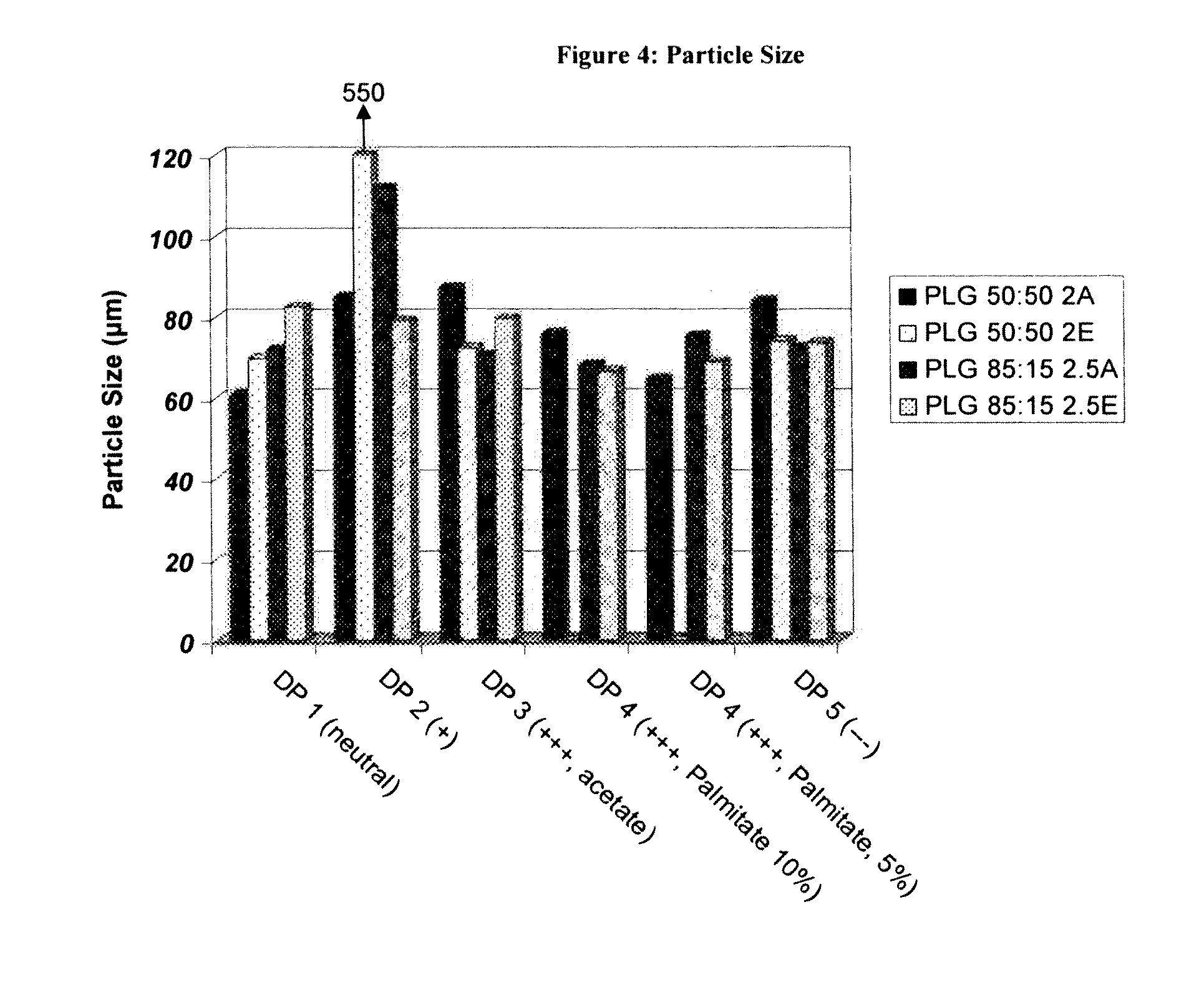Controlled-Released Peptide Formulations
a technology of peptides and peptides, which is applied in the direction of peptides/protein ingredients, drug compositions, peptides, etc., can solve the problems of many challenges in the design of effective controlled release, polymer-based delivery systems, and prevent a more uniform approach to effective encapsulation, so as to reduce or enhance the initial diffusional release of peptides, improve the encapsulation efficiency of such peptides, and modulate the erosion
- Summary
- Abstract
- Description
- Claims
- Application Information
AI Technical Summary
Benefits of technology
Problems solved by technology
Method used
Image
Examples
example 1
Formulation of Model Peptides
[0079]Manufacturing Process:
[0080]The peptide-loaded microparticles were prepared using a standard solvent extraction method. Approximately 200 mg of peptide was dissolved in 2 grams of DMSO. Separately, 2 g of poly(lactide-co-glycolide (PLG) was dissolved in 10 g of dichloromethane. The peptide solution was then added to the polymer solution while homogenizing at high revolutions per minute (rpm) using an IKA homogenizer. The peptide / polymer phase was next dispersed into a continuous phase consisting of 3 g of poly(vinyl alcohol) (PVA) and 2.7 g of dichloromethane in 150 mL distilled water by homogenizing at 700 rpm using a Silverson L4RT mixing assembly. Once the droplets had been sufficiently formed (3 minutes) the emulsion was diluted with 1 L of distilled water and stirred on a stirplate for 1 hour, allowing the extraction of the dichloromethane and solidification of the PLG microparticles. Thereafter, the microparticles were isolated by passing the...
example 2
Exemplary Modifications of Parent Peptides
[0093]Calcitonin
[0094]Calcitonin is a hormone used in the treatment of osteoporosis. The amino acid sequence of human Calcitonin is Cys-Gly-Asn-Leu-Ser-Thr-Cys-Met-Leu-Gly-Thr-Tyr-Thr-Gln-Asp-Phe-Asn-Lys-Phe-His-Thr-Phe-Pro-Gln-Thr-Ala-Ile-Gly-Val-Gly-Ala-Pro (set forth as SEQ ID NO:1).
[0095]The pl of Calcitonin is modified to enhance its use in a controlled released formulation by adding a tri-lysine moiety at the N-terminus to increase its encapsulation efficacy (set forth as SEQ ID NO:2). Alternatively, to increase its initial burst from an ester-terminated polyester, the glycine residues are replaced with lysines (set forth as SEQ ID NO:3). To increase erosional release from an acid-terminated polyester, the glycine residues are replaced with aspartic acids (set forth as SEQ ID NO:4).
[0096]Leuprolide
[0097]Leuprolide is a gonadotropin-releasing hormone agonist that may be used in the treatment of prostate cancer or endometriosis. The amin...
PUM
| Property | Measurement | Unit |
|---|---|---|
| concentration | aaaaa | aaaaa |
| sizes | aaaaa | aaaaa |
| diameter | aaaaa | aaaaa |
Abstract
Description
Claims
Application Information
 Login to View More
Login to View More - R&D
- Intellectual Property
- Life Sciences
- Materials
- Tech Scout
- Unparalleled Data Quality
- Higher Quality Content
- 60% Fewer Hallucinations
Browse by: Latest US Patents, China's latest patents, Technical Efficacy Thesaurus, Application Domain, Technology Topic, Popular Technical Reports.
© 2025 PatSnap. All rights reserved.Legal|Privacy policy|Modern Slavery Act Transparency Statement|Sitemap|About US| Contact US: help@patsnap.com



